How to gather and organize information
Many scientists do not like to write. We would rather discuss and do experiments, attend lectures or teach. But scientists must write. Graduate students must write theses. Postdocs must write papers. Professors must write grant applications. Writing is a big part of what we do.
Some scientists struggle with gathering background information, an important stage of writing a scientific document. We also may struggle to organize this information, another important stage. But we need not struggle so much. With an effective method to gather and to organize information, we can write more quickly, more efficiently and more decisively.
If you do not use a method when writing grants and papers, I invite you to consider the one I share here. First, I will tell you where I got this method. Then I will illustrate how I use it for taking notes while reading articles (Step 1) and for organizing and using these notes to write (Steps 2 through 4).
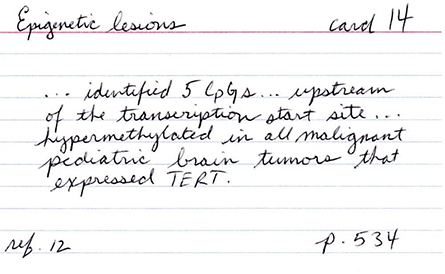
My method is based on an old analog system for organizing information on three-by-five-inch notecards. It starts with writing a single, useful fact in the center of each notecard. In the corners, the writer indicates the source for that fact and the topic it addresses. Each notecard gets an ID number. As the writer reads more and gathers more facts, they accumulate a stack of notecards (like a deck of playing cards). They then deal the cards in the deck into three or four piles. Cards on topic A form one pile; cards on topics B, C or D, other piles. The writer then organizes the cards in each pile (as if organizing a hand by suit or by rank). In this way, they have organized information to plan each sentence and each paragraph of their paper.
I used a digital version of this method to write grants and papers when I was a research technician at the University of Pennsylvania, a graduate student at Yale University, a postdoc at University of Colorado at Boulder and a staff scientist at St. Jude Children’s Research Hospital. By using this method, I became not only a more effective writer but also a more effective reader; this method can help in any endeavor that requires gathering and organizing information from many sources. Here are the four steps I use.
Step 1: How to take notes while reading
Before you read an article, copy into a Word document the following information: the article title, the corresponding author’s name, the publication year, and the figure titles or section titles (abstract, introduction, results, methods, discussion). As you read, copy words and phrases that capture the essence of important ideas from each section. Copy ideas from the article’s abstract into the “abstract” section of your notes, from the introduction to the “introduction” section and so on.
Substitute ellipses for unnecessary words if you retype passages. Although you may trim sentences in this way, your Word document still will become very long as you read more articles (hundreds of pages). Save this valuable document for when you are ready to write. To stay fresh, alternate between reading a few pages of an article and copying passages from those pages.
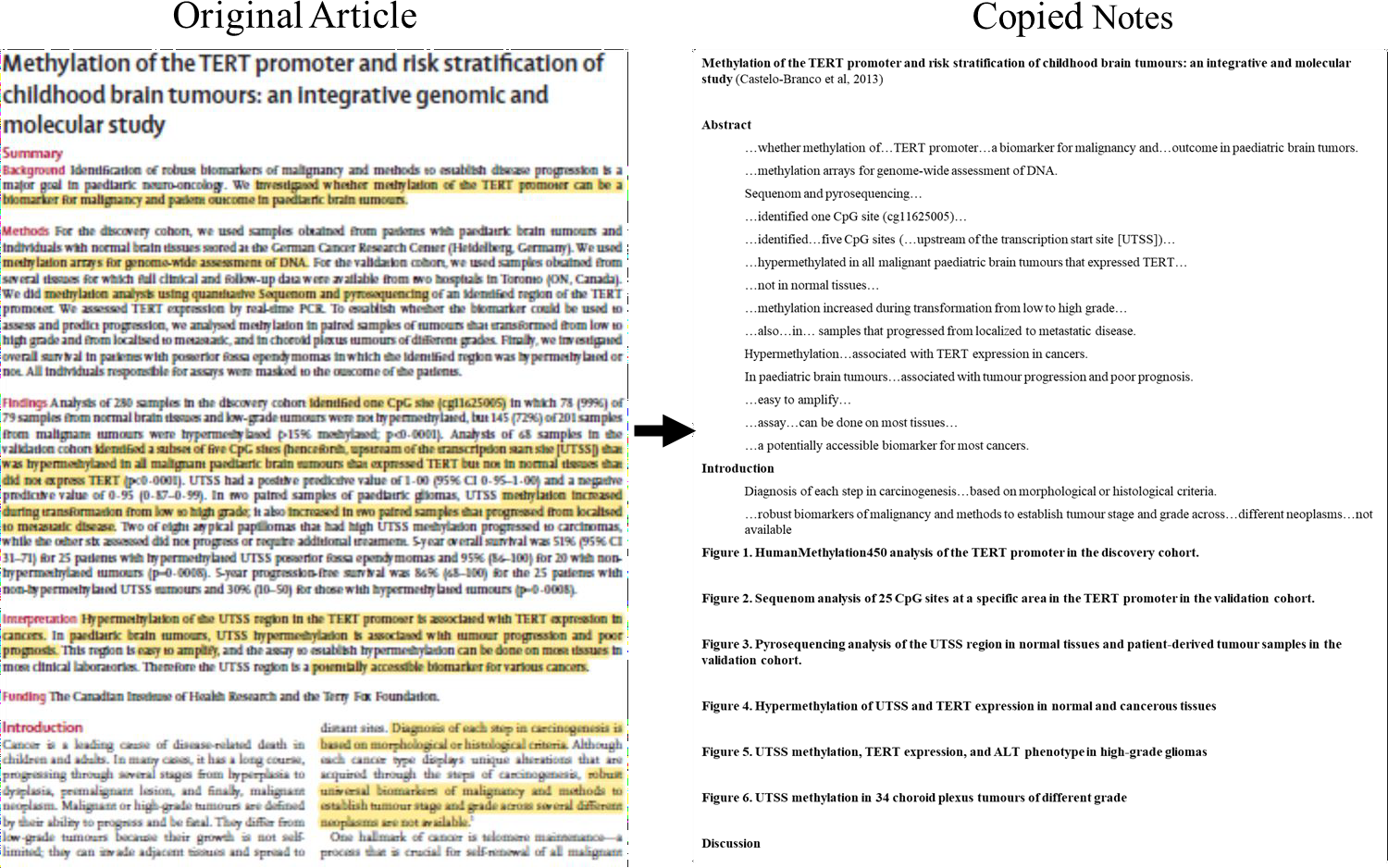
Step 2: How to harvest from your notes
When you need to write a paper or grant, start by identifying articles that are clearly relevant to your subject. Not everything you have read will be relevant for every document. Review your notes from the relevant articles. Highlight passages with useful information.
After harvesting the most relevant notes from the most relevant articles, review notes from articles that may be only moderately relevant to your subject. These moderately relevant articles may contain useful information as well. You probably have forgotten the contents of many papers you have read. You may get excited by the richness of information and the granularity of details in your notes. Do not rush this step. Patiently harvest from your notes. If you have read many articles, you may need a week or more to finish Step 2.
After methodically reviewing your notes, copy the highlighted parts into an Excel file. Copy each note into its own row, and indicate the source of the note. Assign each note a unique ID number.
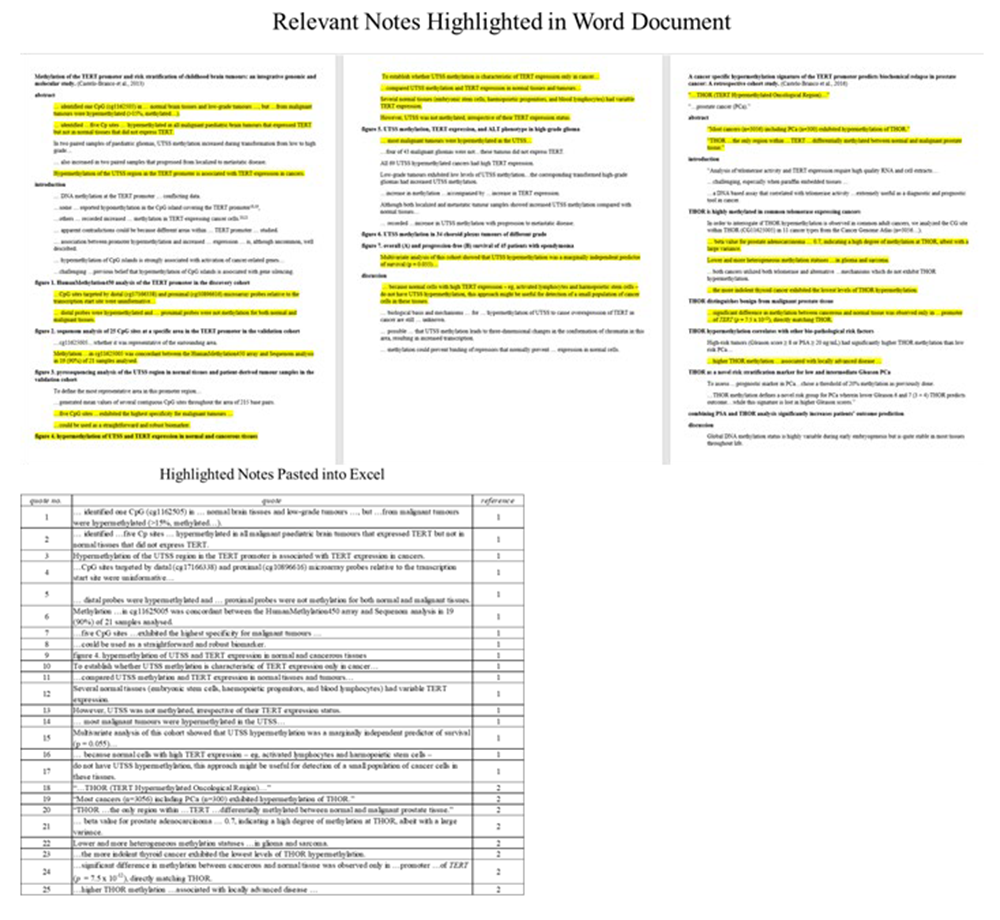
Step 3: How to organize your harvested notes
Identify the key topics you are writing about. Color code your notes by topic. Then sort your notes by color. Determine whether you have read enough to write confidently about each topic by counting notes in each colored bin. You may need to pause here to research topics that are supported by too few notes. After you complete this step (refreshing your memory of the papers that you read and organizing your notes on these papers), ask whether the narrative that you envisioned for your document is the best possible narrative. If not, revise your narrative until you are satisfied.

Step 4: How to write using your organized notes
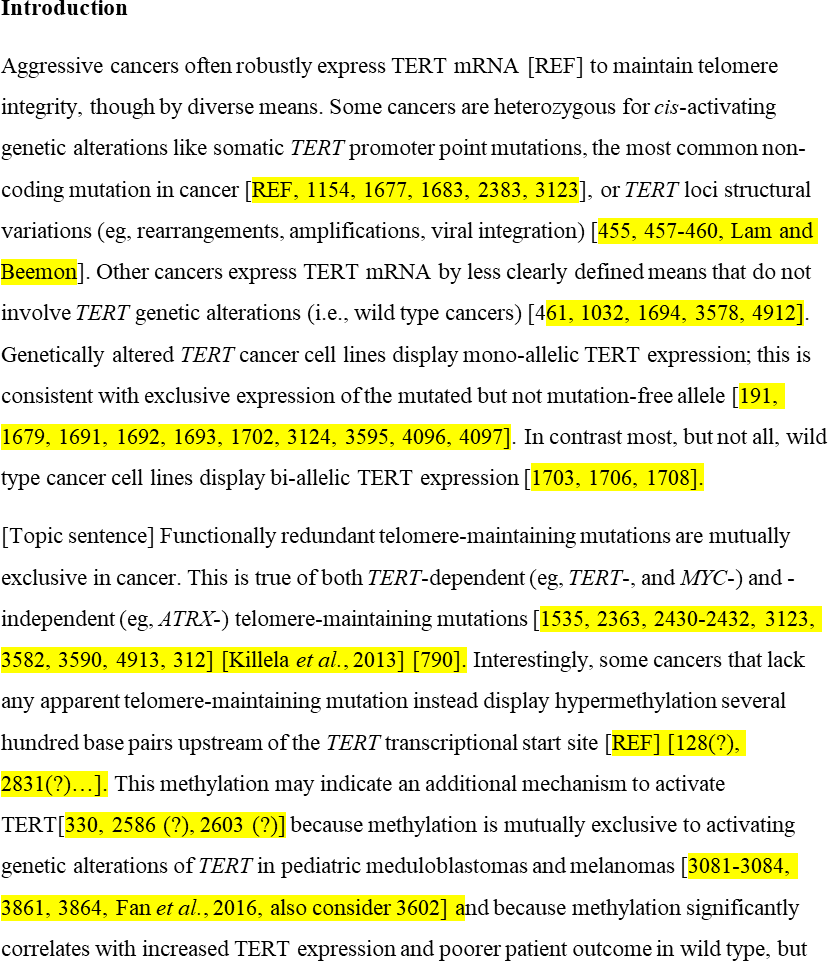
Begin each paragraph with a topic sentence. Build the paragraph, using your notes to write sentences that support, illustrate or expound on that topic. After using a note to write a sentence, indicate the note’s ID number in brackets at the end of the sentence (for example, “It is the most common noncoding mutation in cancer [1154, 1677, 1683, 2383, 3123]”). As you write, record which notes have been used either by crossing the note off or by changing its color in the Excel file. If some notes remain unused, ask whether they should be used or, alternatively, discarded. Do not cite only a few articles; skillfully draw from the breadth of articles you have read. Your notes will be especially useful for writing your introduction, methods and discussion. Write these sections with confidence, because you have done your homework. Each sentence is based not on vague memories of the literature but on direct quotes from peer-reviewed articles.
Your Word and Excel files are proof of your scholarship. Your Excel file is also your citation key. Use it to find which article corresponds to which bracketed note number. Then use a citation managing program (like EndNote or Papers) to replace each bracketed number with the appropriate citation.
Conclusion
You cannot use this method if you are rushed. Long before you need to write, you should read articles continually at your own pace. Using this method, you can remember and methodically organize information from dozens or hundreds of articles. By taking notes while reading and by organizing your notes before writing, you will think and write about your research more clearly, more confidently and more skillfully. You may find writing to be more satisfying and manuscript and grant submissions to be more successful.
Enjoy reading ASBMB Today?
Become a member to receive the print edition four times a year and the digital edition monthly.
Learn moreFeatured jobs
from the ASBMB career center
Get the latest from ASBMB Today
Enter your email address, and we’ll send you a weekly email with recent articles, interviews and more.
Latest in Careers
Careers highlights or most popular articles

Designing life’s building blocks with AI
Tanja Kortemme, a professor at the University of California, San Francisco, will discuss her research using computational biology to engineer proteins at the 2026 ASBMB Annual Meeting.

Upcoming opportunities
#ASBMB26 late-breaking abstract submission opens on December 8. Register by Jan. 15 to get the early rate on our Annual Meeting.

Make your abstract stand out
Ensure your research is impossible to overlook. Get quick, practical reminders for crafting an abstract that attracts readers and helps you build connections at the conference.

Inside industry postdocs
As more Ph.D. scientists look beyond academia, industry postdocs offer a new kind of training, where mentorship meets mission-driven research. Fellows at Pfizer and Genentech share how these programs prepare them to translate discovery into impact.
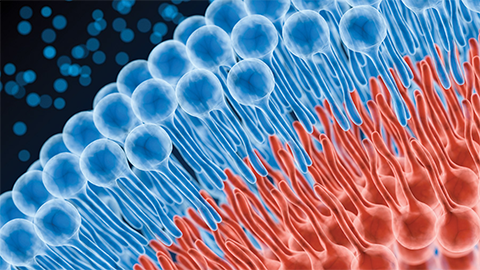
Upcoming opportunities
The Lipid Research Division Seminar Series returns Oct. 15 with talks on recent advances in triglyceride cycling in adipocytes.

Writing with AI turns chaos into clarity
Associate professor shares how generative AI, used as a creative whiteboard, helps scientists refine ideas, structure complexity and sharpen clarity — transforming the messy process of discovery into compelling science writing.

